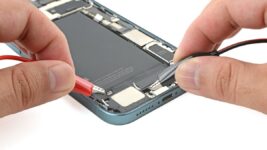The new Apple iPhone 16 is much more repairable than its predecessor. So says no less an authority on the subject of digital device repairability than iFixit. The tip-top teardown troop has scored Apple’s newest handset seven out of 10 for repairability, a hefty upgrade from the mere four out of 10 that the iPhone 15 scored. So, what accounts for the iPhone 16’s improved repairability?
First, Apple had a full, detailed and reportedly very well-written repair manual ready to go for the launch of the new handsets. Next, the internals are well laid out for easy and independent access to numerous components.
“The layout is smart, prioritizing access to critical repairs like battery and camera replacement. In past models, it was normal to see, for example, battery pull tabs blocked by a Taptic Engine, which was blocked by a speaker, which was blocked by a big grounding bracket—all of that having to come out in sequence. The 16’s design offers independent access to the battery, the speaker, the Taptic Engine, cameras, display, back cover, and so on. It’s really thoughtfully laid out,” iFixit says.
There are also some intriguing innovations. Battery extraction on new non-Pro versions of the iPhone 16 is facilitated by a new electrically-activated adhesive that debonds on demand.
“This fancy new sticky stuff can debond when you pass an electrical current through it. That means no more reliance on finicky, brittle adhesive strips, just a consistent, easily repeatable process.”
Slightly oddly, the iPhone 16 Pro non-Max (so, the Pro version but not the larger of the two Pro versions) has a new battery design with a metal casing but without the novel debanding adhesive.
Anyway, iFixit also noted that iOS 18’s new “Repair Assistant” software helps smooth out the integration and activation of newly-fitted parts. “It worked impressively smoothly on our vanilla iPhone 16: one click to pair and calibrate all components at once, and no bugs to be found,” iFixit says.
Of course, the unanswered but lingering question in all of this involves Apple’s motivation. Has the company suddenly recognised the value to its customers of making repairs easier? Does Apple finally realise that manufacturing billions of iPhones and making them very hard to repair has all kinds of suboptimal implications for sustainability and e-waste?
Maybe. But of course, it’s also true that the walls are closing in from a legislative and regulatory perspective. The EU’s upcoming right-to-repair legislation dictates that device makers must publish repair manuals, for instance, along with other requirements around the use of third-party parts and repair services.
Individual states in the US, including Oregon and California, likewise are at various stages of implementing their own right-to-repair rules. Taken all together and bearing the new iPhones in mind, it’s fair to say that quite a few battles are being won in the fight for the right to repair devices we’ve all bought and paid for.
Is the war over? We wouldn’t go that far. But whatever you say about Apple, it’s certainly a very influential player in the digital device market. If Apple’s devices are getting easier to repair, that has to bode well for the industry as a whole.




